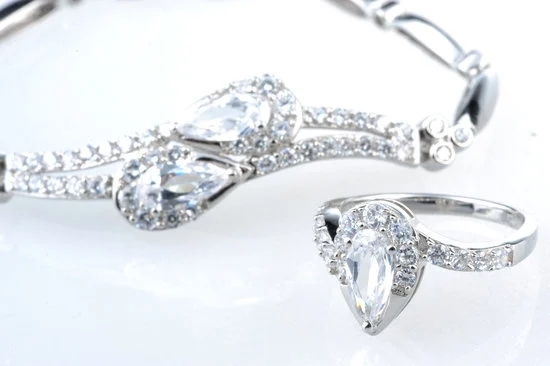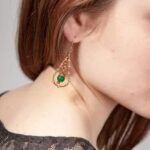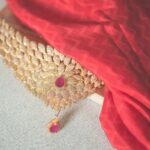Art Deco jewelry is a style of jewelry that is inspired by art from the Art Deco period. This movement began around 1918 and was incredibly popular in France in the 1920s, before spreading to other countries. The defining features of this look include geometric shapes, vibrant colors, and bold lines. As it gained popularity, many people started wearing Art Deco jewelry as a way to make a fashion statement.
The classic elements of Art Deco jewelry have spanned generations and are still popular today. It has been reinvented time and time again to suit new trends and styles while still keeping its unique characteristics. Jewelers jumped on these trends in the late 20th century and added extra dimension to their pieces with more intricate designs. This allowed them to create things like earrings adorned with glittering stones or bold necklaces made of interlocking shapes.
Ads for Art Deco jewelry often feature glamorous models wearing elaborate pieces that are sure to attract attention. Whether they’re promoting a necklace or rings that add an unexpected edge to any outfit, designers must use beautiful images and captivating descriptions to capture the allure of these coveted pieces.
Companies seek out experienced photographers and digital editing teams who can give life to each piece through visual effects, stylish backdrops, and even motion effects that catch viewers’ eyes immediately when scrolling through their news feed or pages online.
By depicting the beauty of each creation in an unforgettable way, Art Deco jewelry ad campaigns ensure consumers will be drawn in by both the product’s appearance as well as its story behind it.
Together with this advertising approach, companies also strive for social media presence which can range from launching platforms where followers can “like” products available for purchase or video campaigns complete with actors telling stories of how being able to wear designer jewels can sometimes be a dream come true.
How Art Deco Jewelry Ads Reflect the Style and Aesthetics of the Time
At the dawn of the 1920s, ad campaigns heavily featured flappers with chic, vibrant attire for savvy shoppers. To capture the eyes of customers, Art Deco was used to create eye-catching displays and captivating advertisements in magazines. These ads were better able to connect with viewers and amplify the new sense of style that had sprung up in recent times.
The Art Deco movement was an expression of modernity: there was a fascination with progress and a confidence in how technology would shape society’s future. Unconventional materials such as colored glass beads, metal mesh, die-cut paper and geometrically shaped elements all worked together to draw attention to jewelry designs. This combination often created pieces with symmetrical proportions; reflected letters, chevrons and squares dancing around circlets or dangling fixtures were only some of its most popular motifs.
Jewelry ads during this time period also tended to focus on female Portrayals. The Flapper generation embraced more relaxed attitudes towards sexuality – something fashion reports recognized by emphasizing jewelry’s use for embellishing those appearances. Ads from brands such as Van Cleef & Arpels featured attractive models (often wearing dresses based on classic designs) showing off their wares in magazine editorials and spreads.
Many pieces echoed the exotic opulence of fabricated silver-work set with cut stones such as sapphire cabochon rings complementary to boldest outfit possible accompany models wearing daring makeup looks too. For more strength into their message that women can have freedom over their lives if they break free from traditional modes of dress-up they were also seen stylized by bravely sporting capes or even long gowns especially emphasizing how much dynamism jewelry can give its wearer.
In a nutshell, Art Deco era jewelry ads gave us a glimpse back into the aesthetics of flamboyant designs that embodied the spirit of creativity and innovation at that time. They encouraged us to embrace personal style without fear or shame – runway trends coming be damned.
As many contemporary fashion pieces still retain similar motifs today-from striking geometric shapes like chevrons or spirals around headpieces all way down rings featuring intricate ribboning-the impact these ads had not been lost upon generations since then.
Elements of Classic Art Deco Jewelry Ad Design
Art Deco jewelry advertisements of the past reflect a timeless design that continues to have an influence today. Art Deco was a prominent genre of artwork between 1910-1930, and its sleek geometric forms can still be seen throughout many dwellings. An Art Deco jewelry ad is no exception; there are several designs that capture its essence and visually draw in the audience’s attention to create an impactful presentation.
The first element found in many Art Deco jewelry ads is its symmetry. Asymmetrical designs are often used throughout the body of the advertisement to create an orderly visual display that showcases the jewelry pieces being promoted. A symmetrical design allows for each piece of artwork on the page to fit perfectly together with repeating patterns and shapes. Overall, this creates an eye-catching ad where all elements flow seamlessly as a whole blend of artistry.
Along with symmetry, strong contrasting colors is another staple of Art Deco jewelry advertising. Bold color schemes are utilized to bring attention towards the details within each piece featured while also maintaining a unified look across all the elements within the piece. Using high contrast shades gives off a modern look that adds depth and dimension to any ad campaign, ensuring it captures attention quickly and stays recognizable even years later.
Finally, visuals such as geometric shapes or graphics play an important role in Art Deco fashion advertising as well. These distinct features often take over key parts of the ads and become focal points, demanding that viewers pay close attention to them in order to fully appreciate their beauty and complexity. Geometric imagery expresses creativity which helps emphasize certain qualities associated with luxury lifestyle brands like Cartier or Chopard, creating a memorable impression for those who see it.
Geometric Patterns and Shapes Found in Art Deco Jewelry Ads
Art Deco jewelry is a highly sought after style of jewelry, which became popular in the 1920s and 1930s. This beautiful, stylish form of adornment has developed a strong following since its introduction and is beloved by many who appreciate its unique appearance.
Art Deco jewelry ads often feature heavily geometric patterns and shapes, inspired by the angular designs featured in the Art Deco architecture movement. Utilizing symmetrical lines, sharp angles, basic shapes like circles and squares, these ads give off a modern and sophisticated feel while still maintaining a vintage aesthetic.
The example of an Art Deco jewelry ad shown above features several examples of these iconic geometric figures. The ad itself contains a central circular design flanked on either side by two additional circles with small triangle decorations tying them together. Each circle contains different images within it.
On the left side is a stylized depiction of a woman’s face with her hair varnished into an angular shape reminiscent of this era’s architecture. On the opposite side is a large ring complete with a brilliant diamond-cut stone set directly in the center. It gives off dazzling sparkles to accentuate the incredible beauty of this precious stone as well as add to its pristine design elements.
The use of these geometric patterns provides visual interest for viewers even before they have had the chance to read any details about what type of jewelry is being offered or how it looks up close. This helps to get viewers interested from afar and encourage them to take that important first step towards eventually investing in such items for themselves or buying them as gifts for others who would appreciate such stunning pieces.
These are just some examples of what makes Art Deco jewelry so wonderfully attractive and timelessly fashionable – qualities helped along greatly by incorporating features found in this style’s unique “architecture” inspired ad campaigns.
Color Schemes Used in Art Deco Jewelry Ads
Art Deco jewelry ads offer an insight into the creative advertising techniques of the era. The advertisements of this time period leveraged iconic imagery, intriguing designs, and unique typography to inspire people to purchase their jewelry.
One of the most exciting aspects of these ads is how they cleverly used bold color schemes to grab people’s attention. In addition to serving as eye-catching decorative elements, the color combinations were carefully chosen to reflect the character and personality of the jewelry being advertised.
The variety of hues employed in Art Deco jewelry ads encouraged potential consumers to think abstractly about what type of statement they wanted their jewelery to make. Common palettes included golden yellows, turquoise blues, ruby reds, deep greens and more – allowing for a vast range of possibilities that captured distinct moods and impressions associated with each piece of artistry. Elegant duos like black and white made for truly timeless pieces while bright pastels embodied a more whimsical sentimentality.
At times, certain shades were even used symbolically – emphasizing certain traits or ethical qualities admired by society at that time such as vitality or classiness. The use of complimentary colors was also often seen in Art Deco jewelry ads as it created visually striking compositions that called attention to many stimulating details within a piece’s design – enticing potential customers all the more.
All in all, it is incredibly impressive just how much thought went into these inventive works of graphic design when attempting to showcase luxurious consumer products such as diamonds, rubies and sapphires.
Examples of Famous Art Deco Jewelry Ads
It should come as no surprise that the style of jewelry ads changed dramatically between the 19th century and the 20th century. As modern visual advertising emerged, so did the use of Art Deco for jewelry advertisements. This trend included both print media and television commercials, and each type of advertisement created unique styles and designs to showcase pieces of jewelry in a stylish way.
Art Deco jewelry ads from this period featured bold lines, curves, geometrical patterns, and vibrant colors to capture viewers’ attention. They often focused on incorporating aspects from futuristic architecture and design elements, such as domed structures, zigzag lines, geometric shapes, bright colors like gold, silver and bronze; along with art deco motifs like sunbursts or abstract flora. Some of the most famous Art Deco jewelry ads include luxury brands Tiffany & Co., Cartier and Van Cleef & Arpels.
The purpose of these ads was to show how luxurious these pieces were and how they could elevate one’s status within society. For example, iconic diamond jewelry house Cartier released an advertisement in 1925 featuring an image of a woman in evening wear wearing a statement piece which was accented with gold chains. It was placed alongside a black background which highlighted its intricacy even further.
While many brands used celebrities or high-profile models to promote their products during this time period, some went against the grain by using seemingly random people to promote their products-demonstrating it can be worn by anyone regardless of social standing or wealth level if desired.
Coco Chanel even said “jewelry changes not just your look but your attitude”; It is true to say that wearing pieces from iconic brands can give wearer that certain difference atmosphere in any occasion.
As we continue into 2021, we expect to see new takes on these classic styles in modern advertising campaigns for jewelry across all mediums-both digital and traditional outlets alike. Art Deco remains an integral part of fashion history with its intricate details able to give us goosebumps every time we look at it.
How to Use Art Deco Jewelry Ads To Enhance Your Current Look
Utilizing Art Deco jewelry ads to enhance your look can be a great way to add an artistic flair to any ensemble. Not only do these ads depict the beautiful designs from this era in history, but they are also highly sought after for their vintage glamour.
This type of jewelry was extremely popular during the 1920s and 1930s and is still considered a sign of luxury today. Whether you’re looking to add a touch of modern style or just want to mix up your accessories, using art deco jewelry ads can be the perfect solution.
One way that you can use Art Deco jewelry advertisements is by searching through publications that featured them back when they were first on sale. Many archival collections at libraries offer magazines full of gorgeous illustrations of jewelry pieces.
You may find something that speaks to you, whether it’s a pendant necklace, a bracelet, earrings or more. Using these images as inspiration can help you draw your attention towards certain pieces and help you decide what styles suit your personal taste best.
When looking for Art Deco jewelry ads online there is no shortage of stunning pieces for purchase. From simple yet elegant bar pins crafted from gold or silver to sparkling diamond cufflinks and spectacular drop earrings featuring sapphires or rubies – it’s easy to find something in the style that suits you perfectly.
If starting from scratch isn’t in the budget, consider browsing through online retailers who offer recreation editions for purchase at fraction cost. With so many options available it’s great knowing that no matter where you shop, replicating looks inspired by these advertisements will not break the bank.
No matter how you choose to utilize them, Art Deco jewelry advertisements are a fantastic way add beautiful vintage flair into your wardrobe without having to compromise on quality or authenticity. From accessing them through archives or finding stunning vintage pieces online – art deco adverts are truly one of the most effective ways one can possible re-imagine how they accessorize their outfits day-to-day.
The Global Impact of Art Deco Jewelry Ads on Contemporary Aesthetics
The Art Deco movement of the 1920s had a profound impact on modern-day aesthetics. Taking its inspiration from Ancient Egypt, this tangible style emphasized linear geometry and bold colors, used as a powerful visual expression to convey modernity.
This artistic divergence gave rise to new mediums of advertising, with print being among the most popular. In today’s day and age, Art Deco jewelry ads can be found in popular fashion magazines and websites, displaying an unprecedented level of sophistication in design that continues to influence our perception of style and beauty.
One of the most iconic features of Art Deco jewelry is its distinctive shapes. Its geometric patterning is both eye-catching and aesthetically pleasing, setting it apart from other decades’ styles.
Due to its distinctiveness, designers have since utilized these shapes for their contemporary projects; whether for a logo or jewelry designs, these geometric patterns serve as an ideal combination between established traditions yet fresh ideas. Additionally, bold colors often present in Art Deco jewelry ads bring out thelively details while remaining open to experimentation in hues; therefore allowing branding companies to develop trademark images through updated palettes.
Art Deco Jewelry Ads are also remembered for their narrative quality that brought out sellers’ product stories more elaborately than before – rather than manifesting its literal worth. This technique helped people understand the cultural heritage behind certain jewelry pieces much faster than ever before discussed in ads.
Nowadays, this trend remains true by emphasizing particular elements such as commitment toward craftsmanship or simply conveying sparkling opportunities that customers could benefit from if they were wearing a particular accessory piece. All these messages shape up the way we perceive fashion trends now: Inspired by unique approaches taken by predecessors but refined so with studied accents for audiences across all ages and nationalities.

Welcome to my jewelry blog! My name is Sarah and I am the owner of this blog.
I love making jewelry and sharing my creations with others.
So whether you’re someone who loves wearing jewelry yourself or simply enjoys learning about it, be sure to check out my blog for insightful posts on everything related to this exciting topic!





